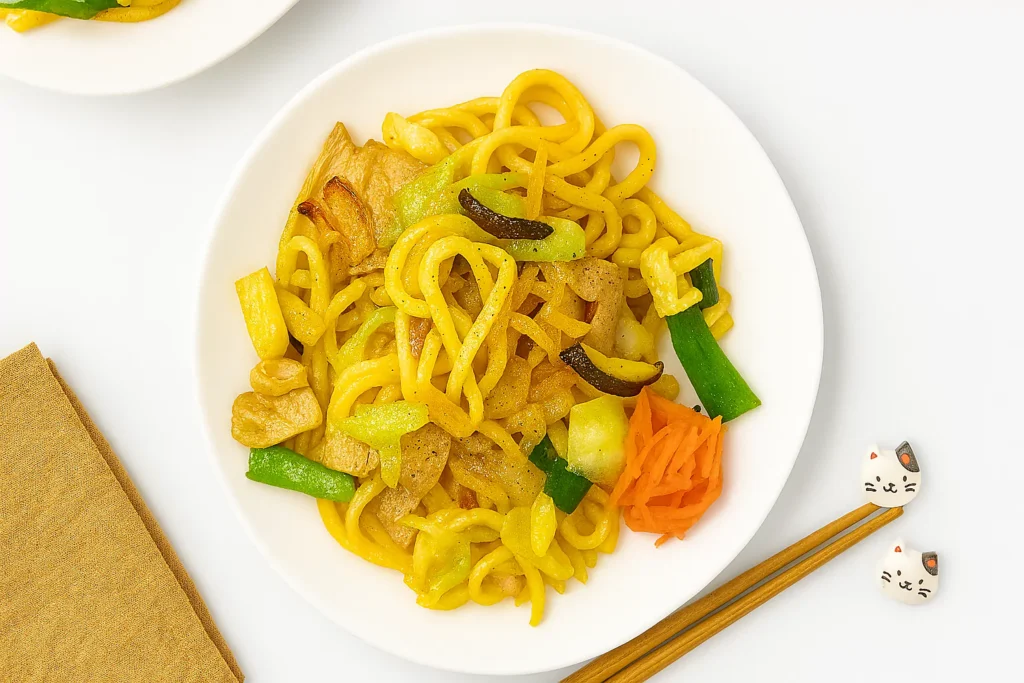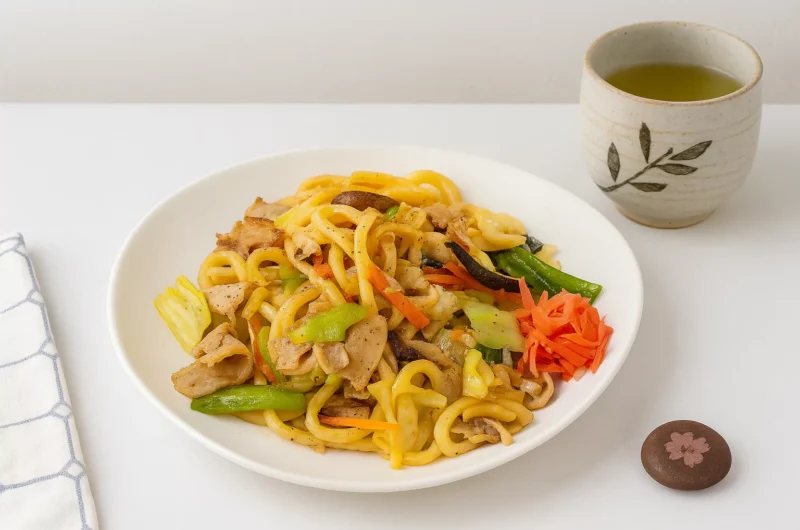Ever Wondered Why Yaki Udon Tastes So Comforting?
What is it about stir-fried noodles that feels like a warm hug? Could it be the rich umami flavor, the chewy noodles, or the simple joy of tossing everything in a single pan? Many people assume noodle stir-fries are tricky or time-consuming—but Yaki Udon (or YakiUdon) proves otherwise. This delightful Japanese dish is quick, customizable, and surprisingly satisfying, making it perfect for busy weeknights or lazy weekends. Curious to know what makes this noodle bowl so irresistible? Let’s dig in.
Why You’ll Love Making Yaki Udon
Yaki Udon is a stir-fried noodle dish that brings together chewy udon noodles, savory pork belly, crunchy vegetables, and a deeply flavorful sauce. Ready in just about 30 minutes, this recipe is easy enough for beginners but satisfying enough for seasoned cooks. You don’t need special equipment or rare ingredients, and you can adapt it based on what’s in your fridge. Whether you’re cooking for one or a family, Yaki Udon fits the bill for a hearty, home-cooked meal without the fuss.
- Total Time: ~30 minutes
- Skill Level: Easy
- Servings: 2 generous portions
- Ideal For: Weeknight dinners, lunch prep, last-minute meals
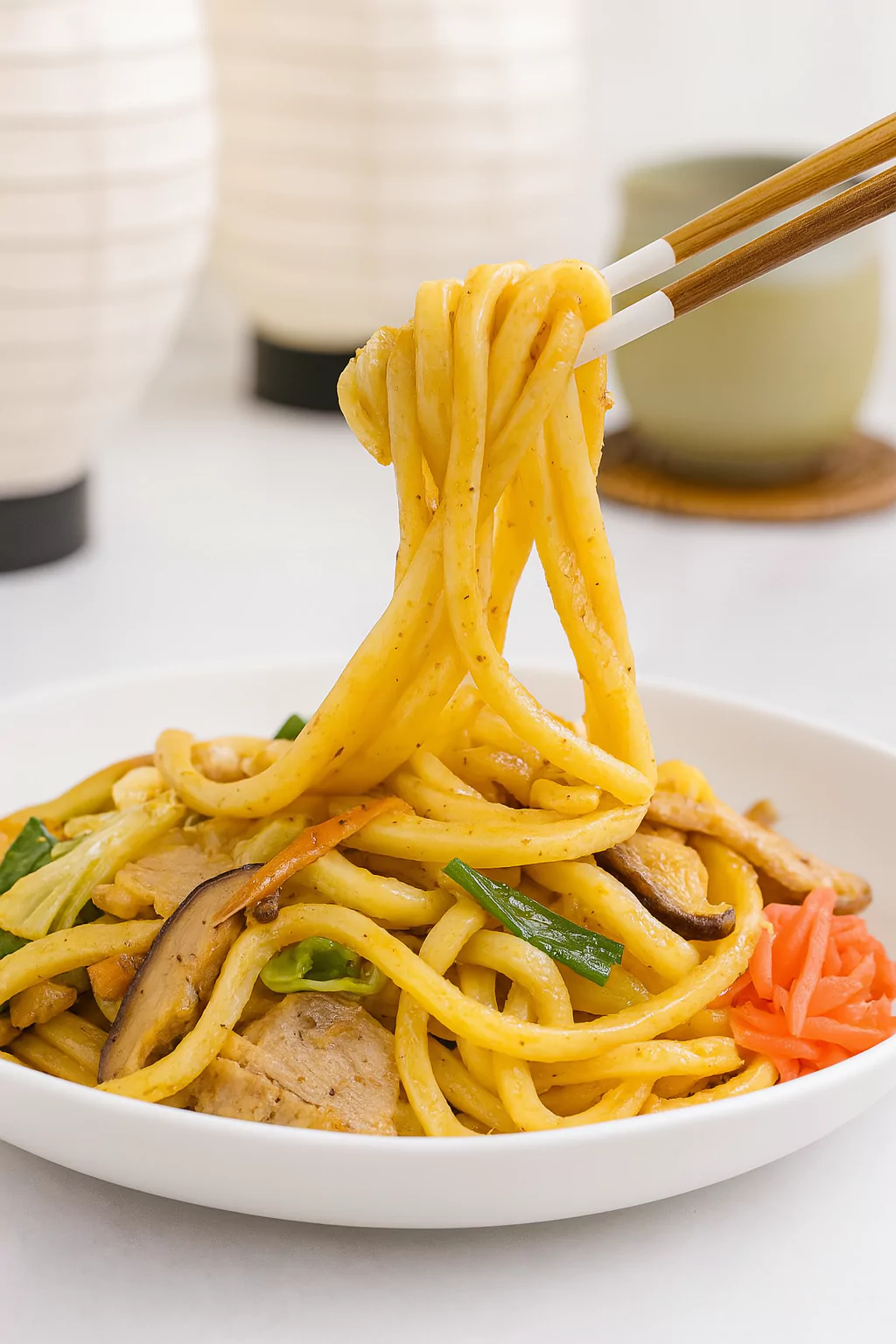
Yaki Udon (焼きうどん) @JapanDishes
What Is Yaki Udon (焼きうどん)?
Yaki Udon is a well-loved Japanese noodle stir-fry that features thick, chewy udon noodles tossed with vegetables and your choice of meat or seafood. The word “yaki” means grilled or fried, and “udon” refers to the thick wheat noodles that are the star of the show. Yaki Udon became popular in southern Japan during wartime, when rice was limited and thick wheat noodles like udon were a practical alternative. Since then, Yaki Udon has become a beloved comfort food known for its chewy noodles, rich umami flavor, and flexibility. Whether made in restaurants or home kitchens, it captures the essence of everyday Japanese cuisine—simple, nourishing, and delicious.
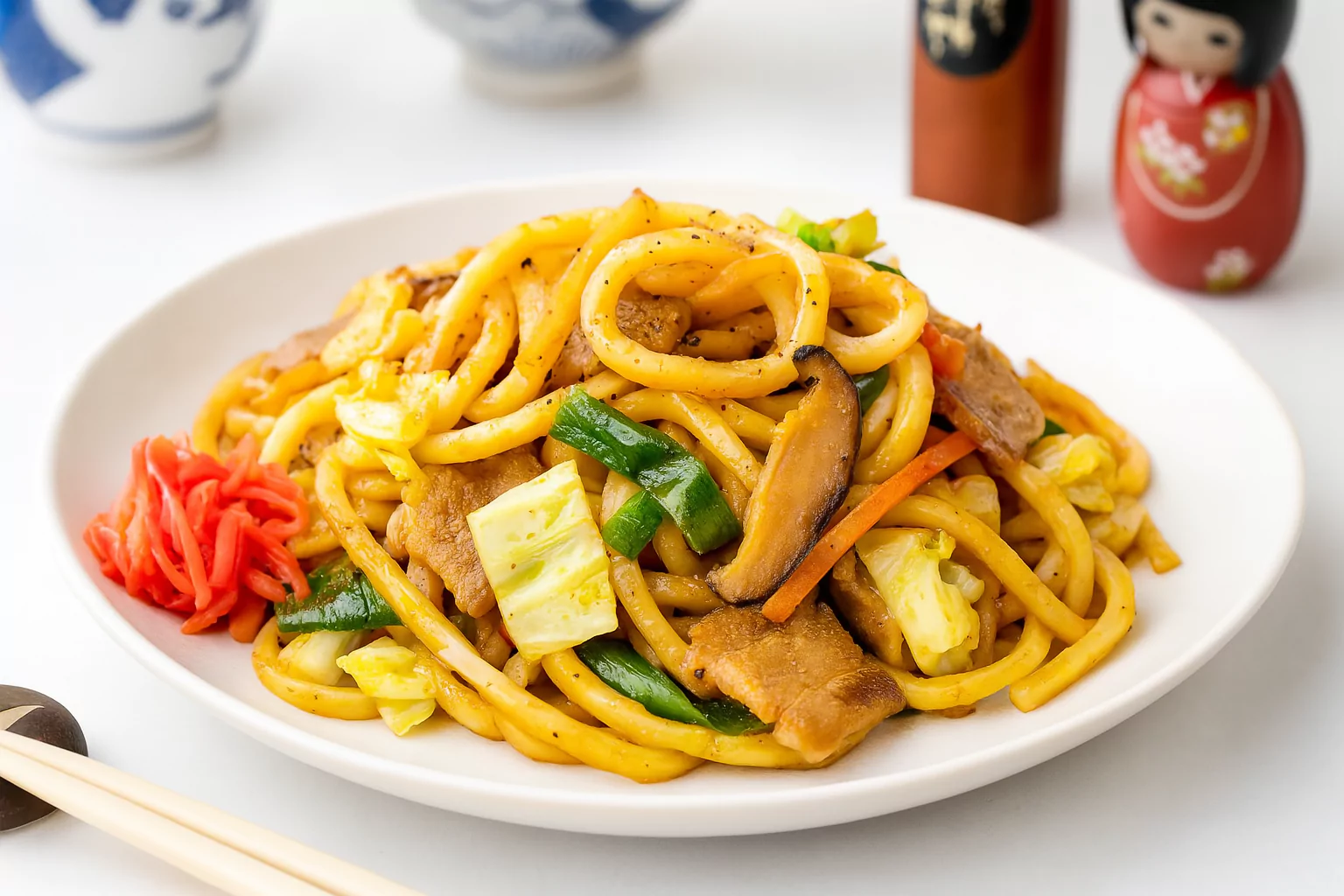
Yaki Udon (焼きうどん) @JapanDishes
Jump to Recipe Print RecipeEssential Ingredients: What You’ll Need and Why
To make authentic Yaki Udon, you’ll want a few core ingredients. These work together to create texture, flavor, and balance.
Vegetables
- Onion (½ piece): Adds natural sweetness and depth.
- Green Cabbage (2–3 leaves): Brings crunch and a mild bitterness that balances the sauce.
- Carrot (2 inches): Provides color, sweetness, and texture.
- Shiitake Mushrooms (2 pcs): Contribute umami and a soft bite.
- Green Onions (2): Give a sharp, fresh finish.
Protein
- Sliced Pork Belly (6 oz): Traditional choice for its richness, but you can swap with chicken, shrimp, tofu, or mushrooms for a vegetarian twist.
Noodles
- Udon Noodles (2 servings): Choose frozen or parboiled for the best chewy texture. Dry noodles also work with proper cooking.
Seasoning Options
- Option A:
- Dashi powder
- Soy sauce
- Sake
- Mirin (or sugar substitute)
- Option B:
- Mentsuyu (3x concentrated)
- Soy sauce
Extras (Optional)
- Katsuobushi (Dried Bonito Flakes): Traditional garnish that adds flavor and movement to the dish.
- Pickled Red Ginger (Beni Shoga): Cuts through the richness with a tangy kick.
Cooking Oil and Seasoning
- Neutral Oil (1 Tbsp): For frying.
- Salt & Pepper: To taste and enhance all ingredients.
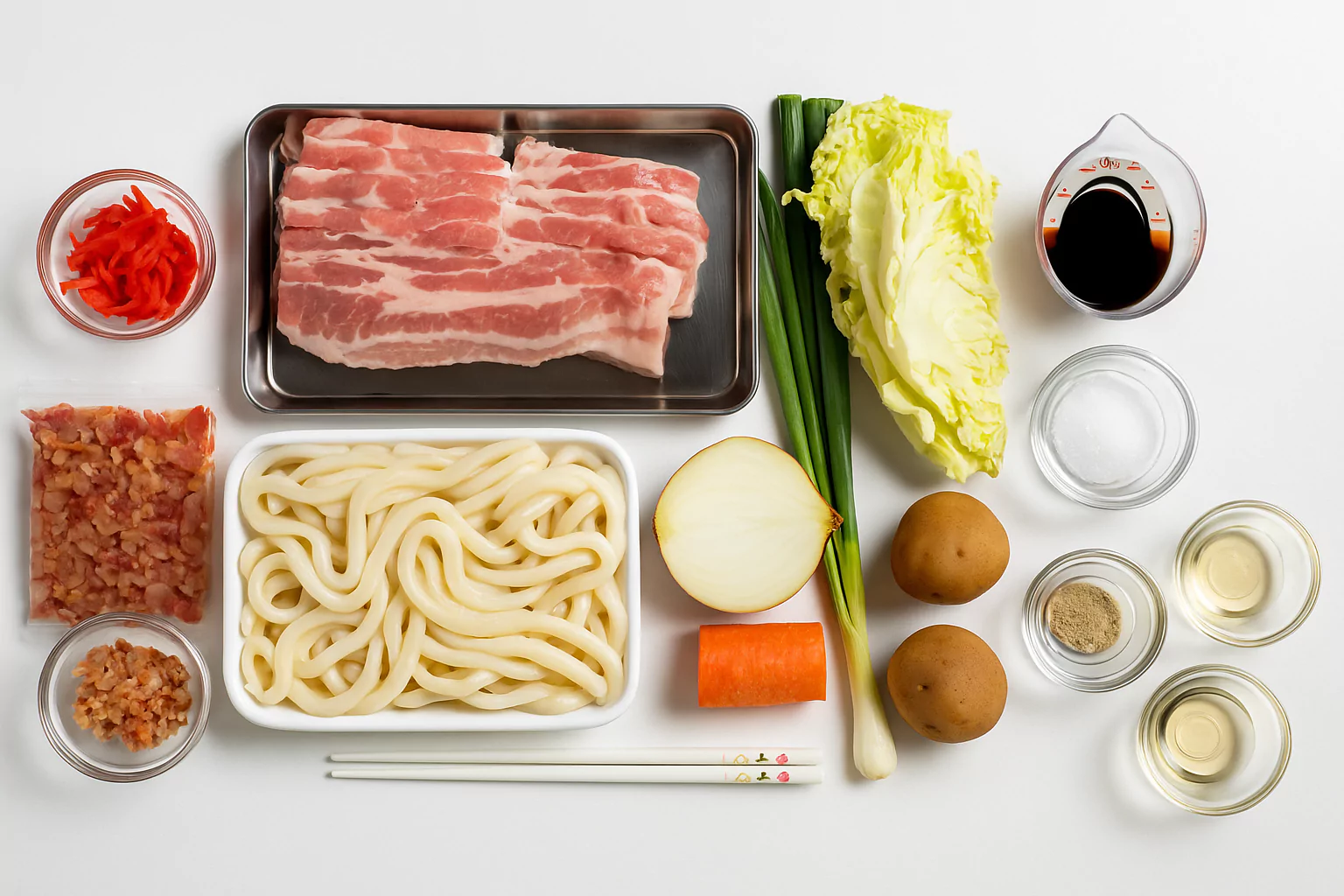
Substitution Tips:
- Use firm tofu or mushrooms instead of meat for a plant-based version.
- If you can’t find dashi or mentsuyu, a mix of soy sauce, sugar, and a bit of stock can work as a base flavor.
Step-by-Step Instructions: How to Cook Yaki Udon
We’ll walk through each step in a simple way so it’s easy for you to follow.
1. Prep Your Ingredients
- Thinly slice ½ onion.
- Cut 2–3 cabbage leaves into 1-inch squares.
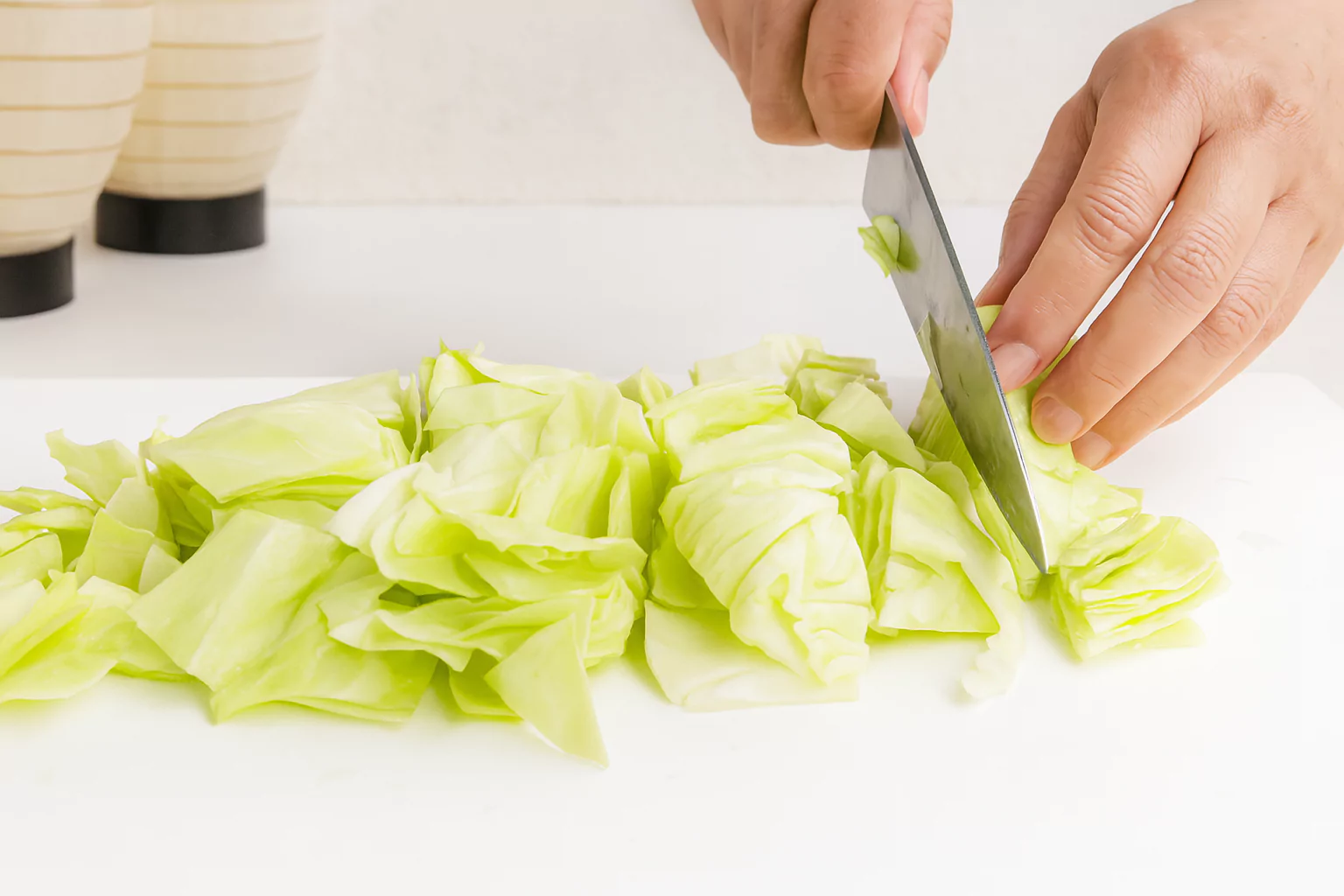
- Julienne 2 inches of peeled carrot into matchstick strips.
- Remove shiitake stems, slice the caps.
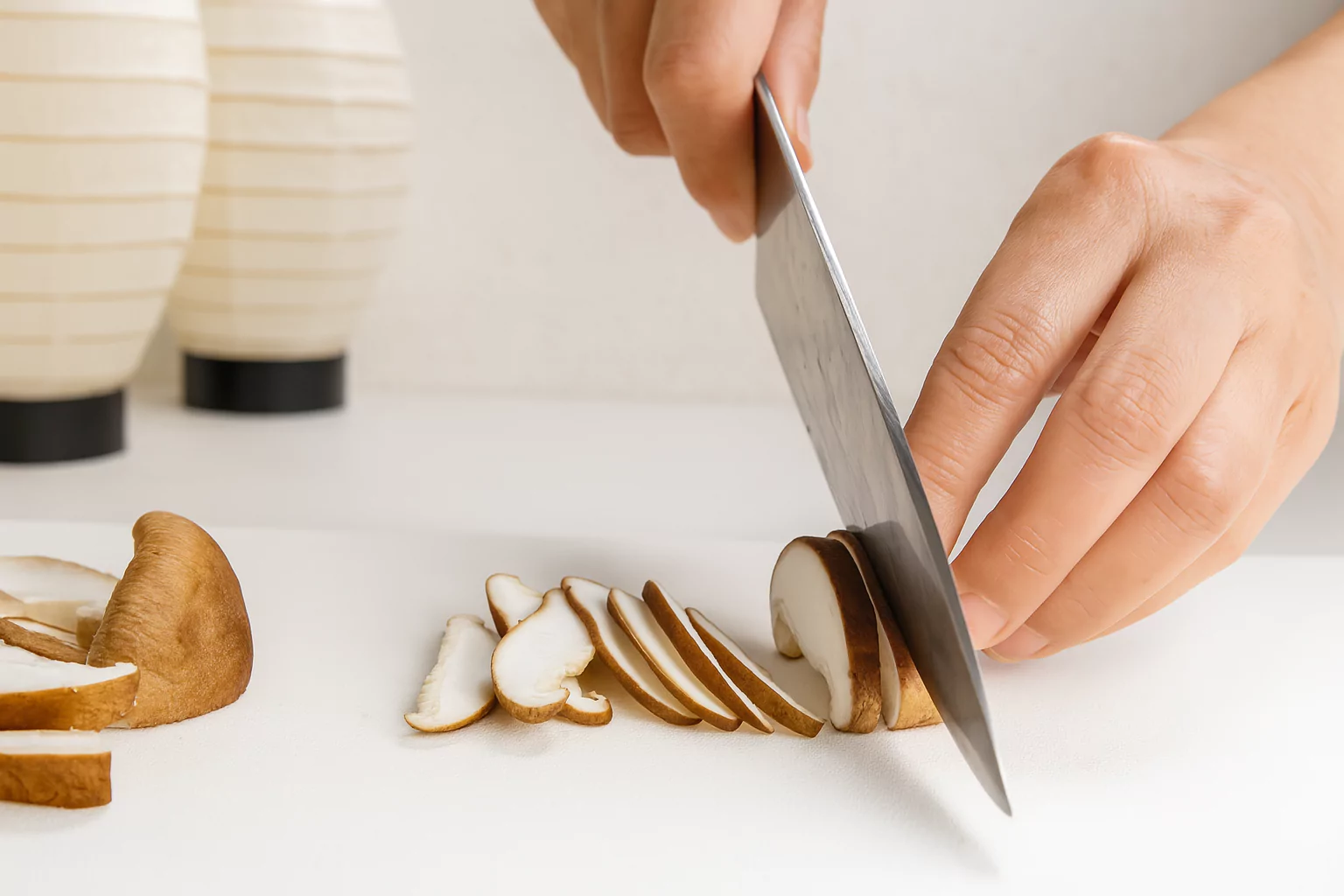
- Chop green onions into 2-inch segments.
- Cut pork belly into 1-inch pieces.
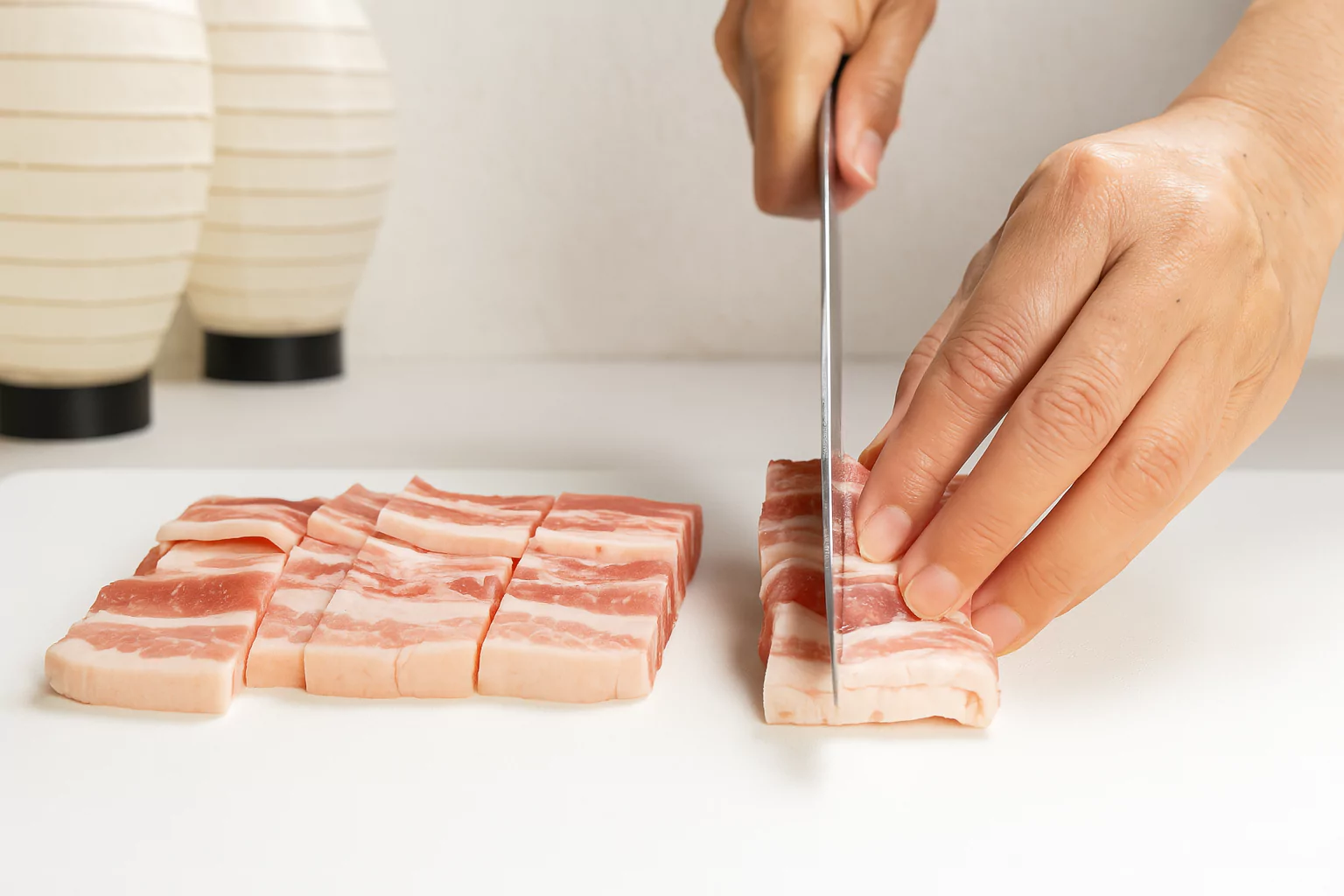
2. Boil the Udon
- Bring a pot of water to a boil.
- If using frozen or pre-cooked udon: Blanch for 30–40 seconds until loosened.
- If you’re using dry udon noodles, prepare them by following the directions on the package.
- Drain and set aside.

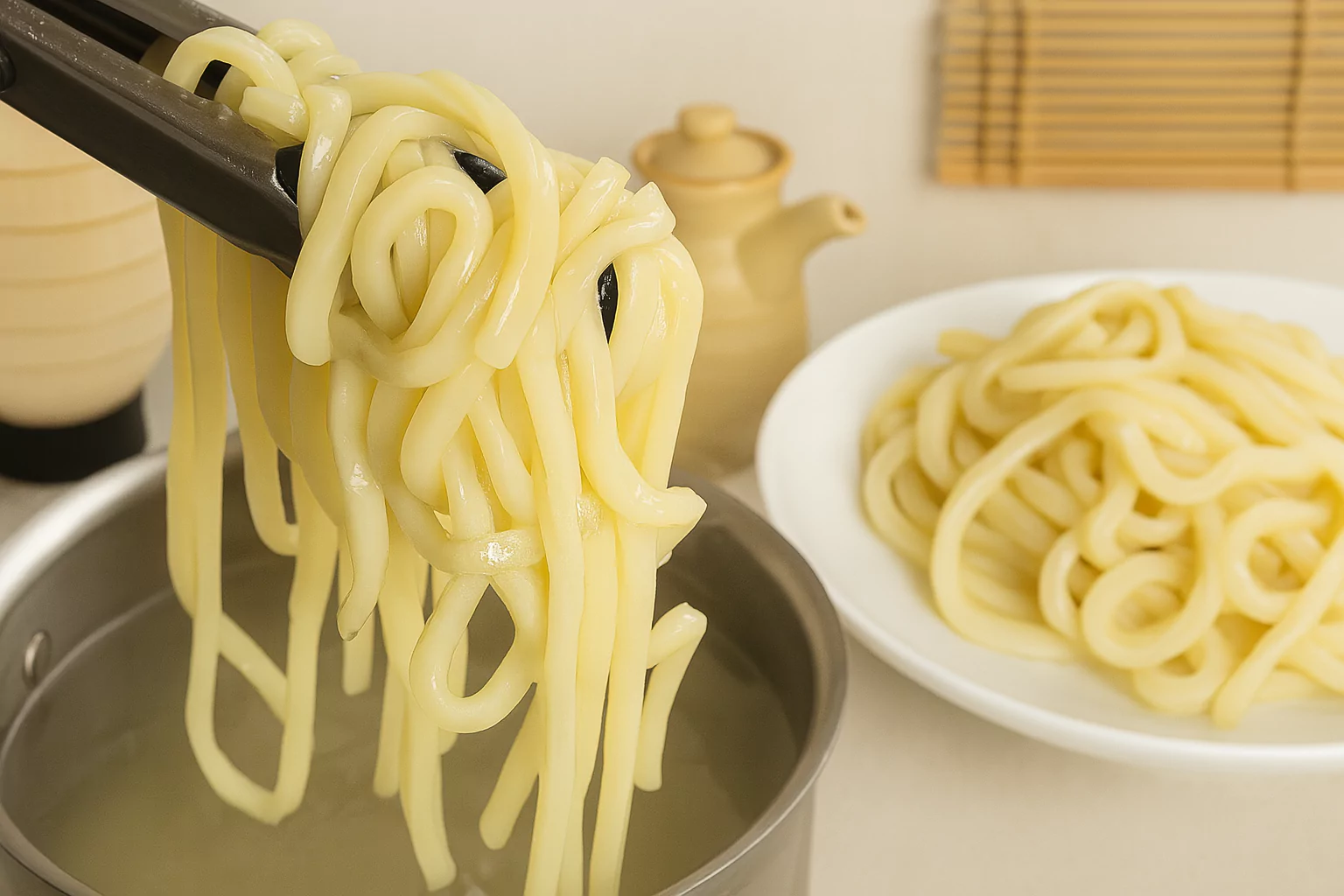
3. Start the Stir-Fry
- Heat a large pan over medium heat.
- Pour in 1 tablespoon of neutral oil and gently tilt the pan to spread it evenly.
- Add pork belly, seasoning it with a pinch of salt and pepper. Cook until no longer pink.
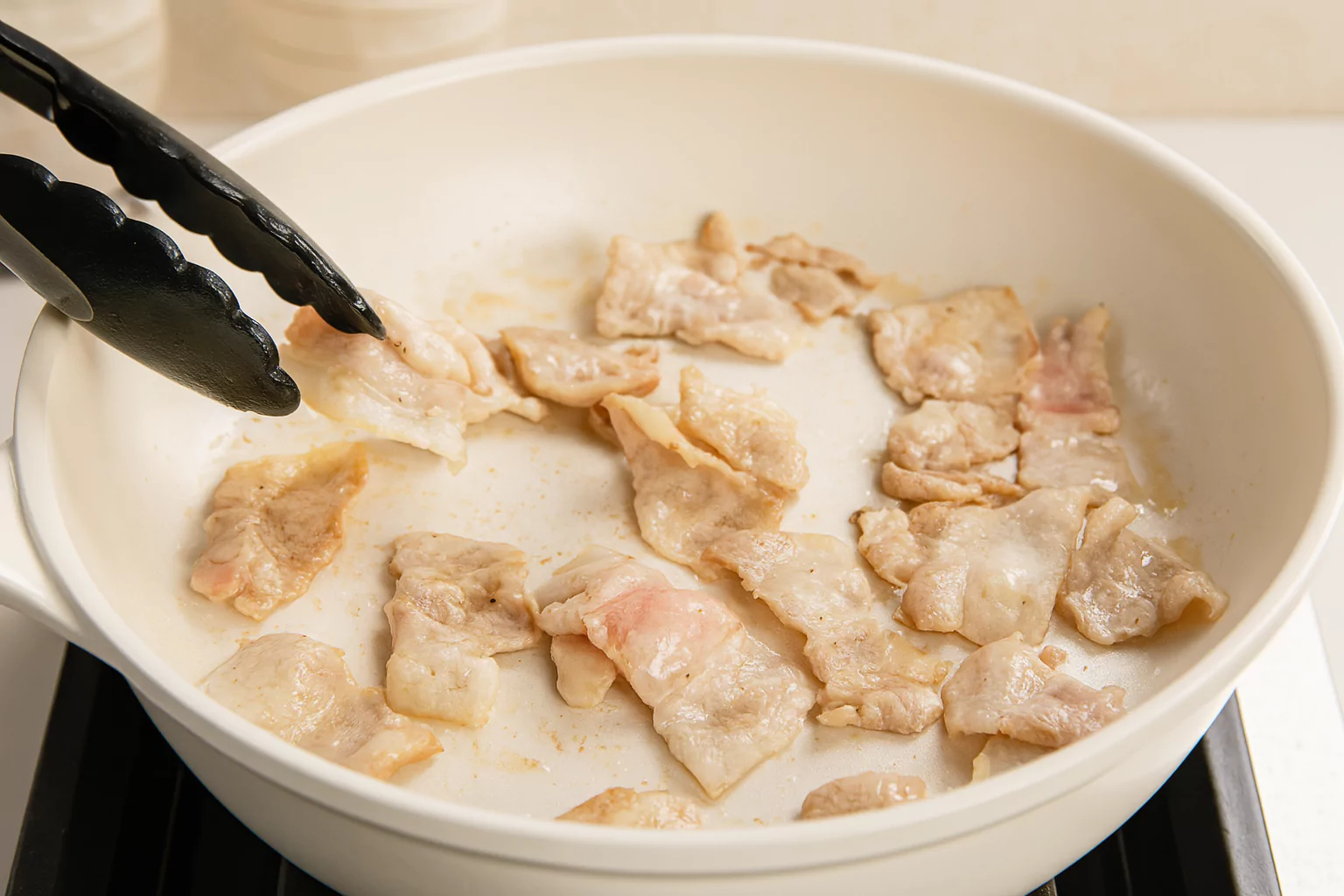
4. Add Vegetables
- Toss in onions and stir-fry until soft.
- Add cabbage, carrots, mushrooms, and green onions. Stir to coat in oil.
- Place a lid on the pan and let everything steam over low heat for about 3 minutes, just until the vegetables soften a bit.

5. Combine Noodles
- Add udon noodles to the pan and mix with tongs for even distribution.

6. Season the Dish
- Choose your seasoning option:
- For Option A, mix in ½ teaspoon of dashi powder, 2 tablespoons of soy sauce, 1 tablespoon of sake, and 1 teaspoon of mirin.
- For Option B, stir in 3 tablespoons of mentsuyu and 1 teaspoon of soy sauce.
- Toss everything together, taste, and adjust seasoning.
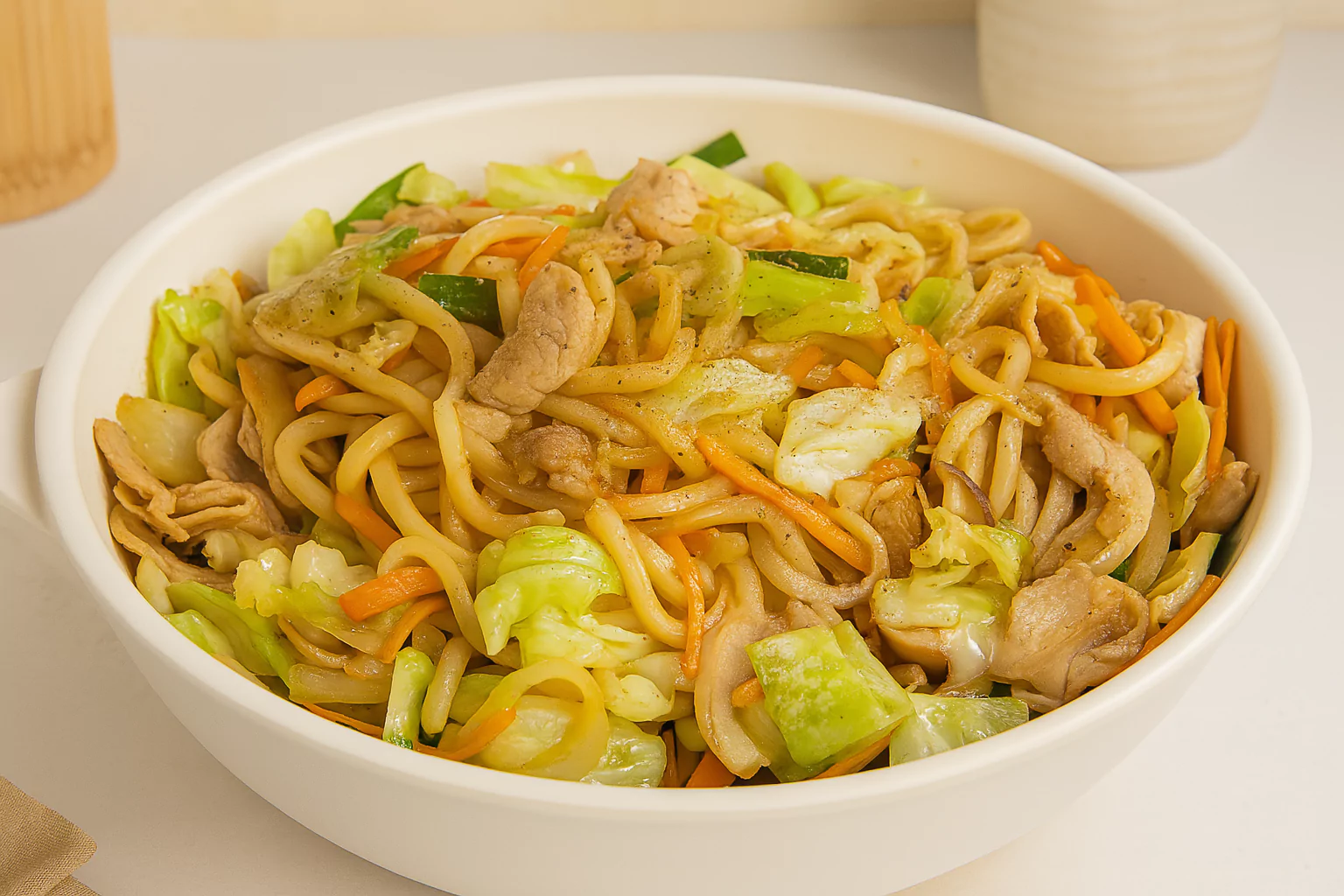
7. Serve
- Plate the noodles and top with katsuobushi and red ginger, if using.
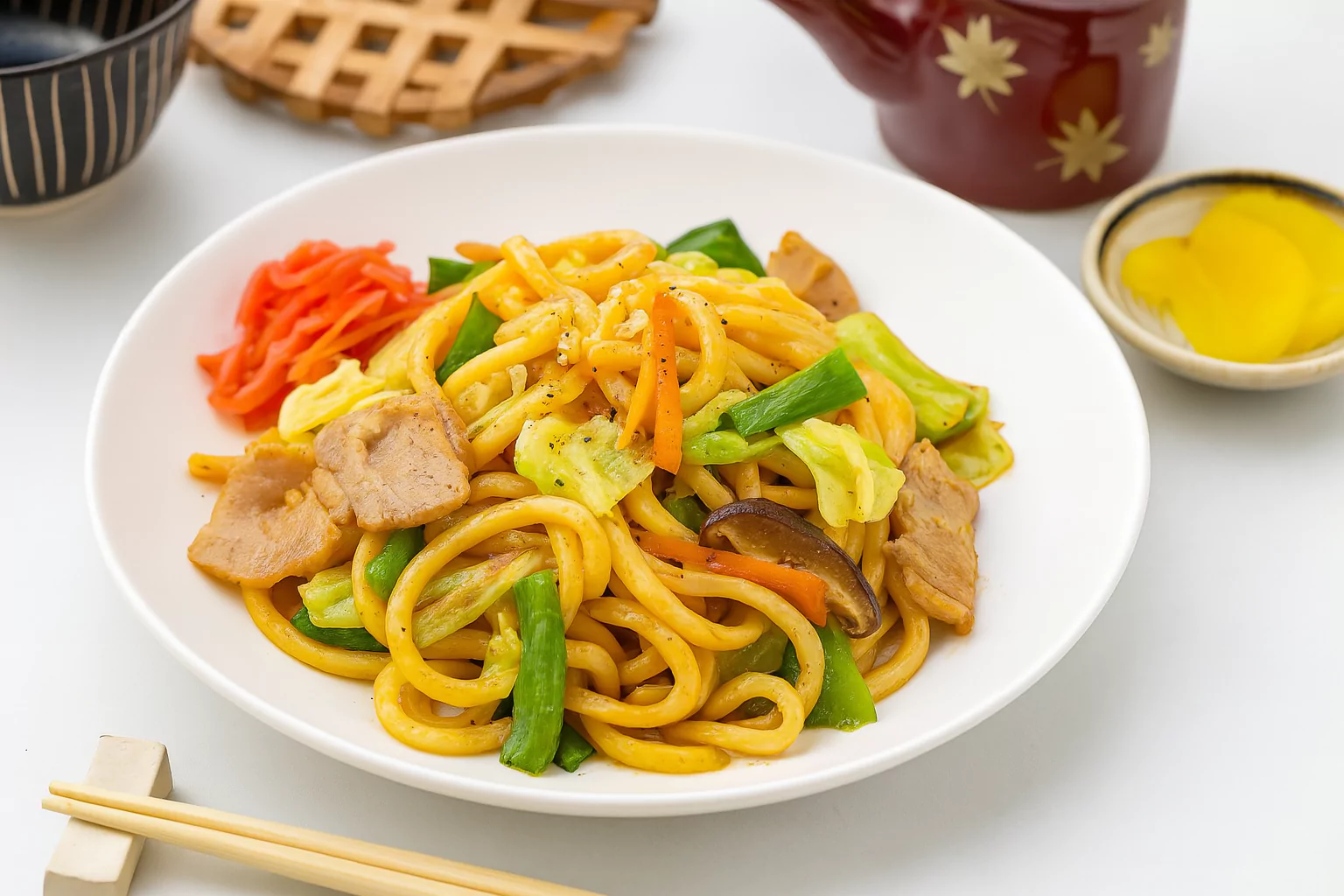
Yaki Udon (焼きうどん) @JapanDishes
Secrets to Success and Expert Tips
- Use Frozen Udon: They give the best chewy texture. Avoid overcooking—blanch just until separated.
- Cook on High Heat: Especially after adding the sauce, this helps the noodles absorb flavor and get a slight char.
- Don’t Skip the Lid: Steaming vegetables for a few minutes keeps them tender yet crisp.
- Toss, Don’t Stir: Use tongs to mix everything without breaking the noodles.
- Make it Your Own: Don’t be afraid to tweak the recipe based on what’s available.
Assembly: Bringing It All Together
Building the perfect Yaki Udon bowl isn’t just about flavor—it’s also about presentation.
Start with a warm plate or bowl. Neatly pile the noodles in the center. Tuck the vegetables and protein around for contrast. Sprinkle dried bonito flakes on top so they “dance” with the heat. Add a dash of red pickled ginger on the side. Keep it simple and clean to highlight the dish’s natural beauty.
Hana’s Recipe Tips
Hana, a home cook who grew up watching her grandmother prepare YakiUdon, shares a few helpful tips:
“Always use high heat and cook quickly. Prep everything before you start frying. And don’t crowd the pan—give ingredients room to breathe. Also, if you can, add a touch of sesame oil at the end for aroma—it makes a big difference!”
These small habits bring home-style magic to your stir-fry.
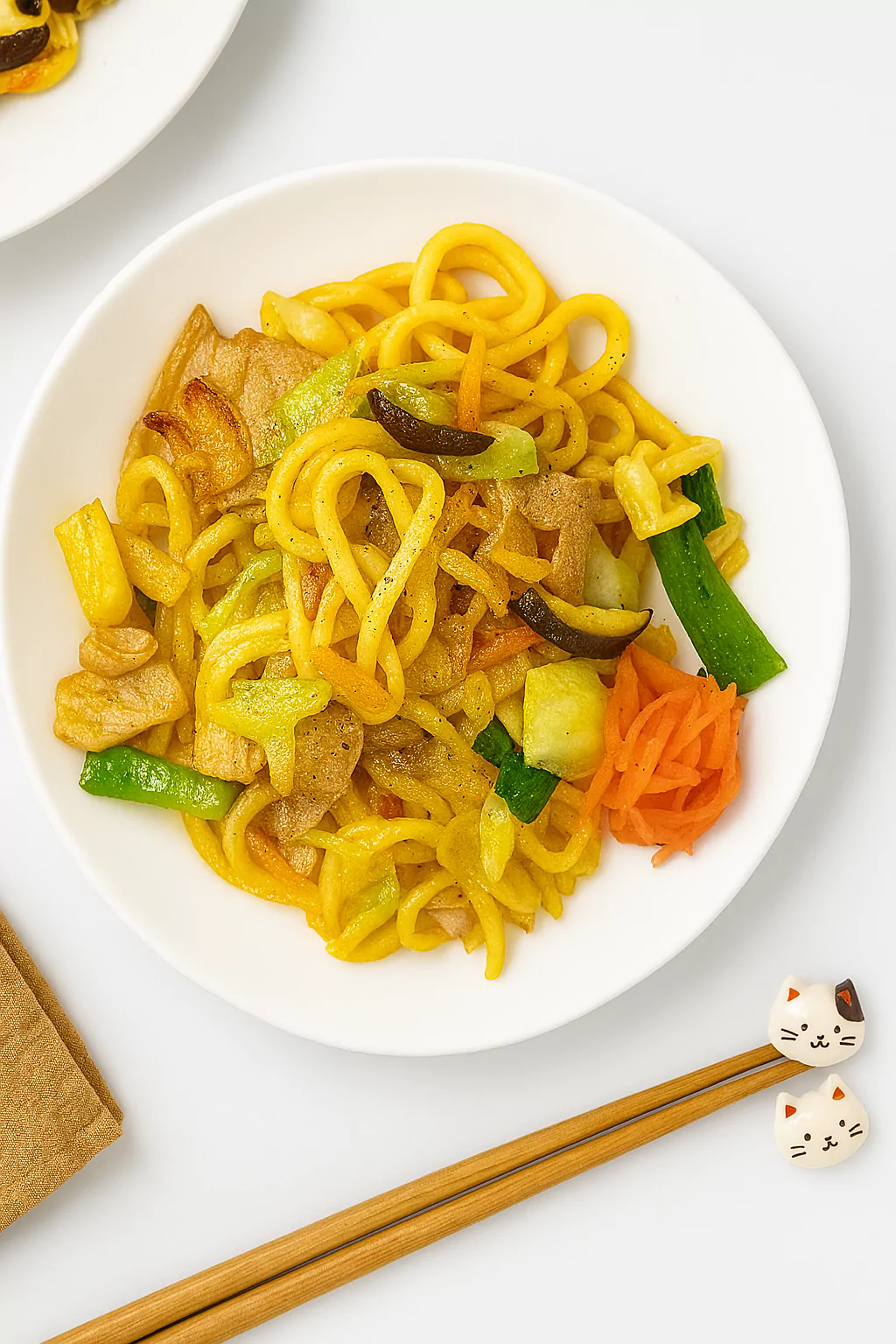
Storage and Make-Ahead Tips
While Yaki Udon tastes best right after cooking, any leftovers can still be enjoyed later.
- Refrigerate: Keep the noodles in a sealed container in the fridge for up to three days.
- Reheat: Warm them in a skillet over medium heat, adding a bit of water or broth to bring back their original texture.
- Make-Ahead: Chop all veggies and portion your sauce the night before to save time. Blanch your noodles in advance and store them lightly oiled to prevent sticking.
Recipe Variations: Customize Your YakiUdon
- Spicy Kick: Add a drizzle of chili oil or sliced red chili.
- Seafood Lovers: Replace pork with shrimp or scallops.
- Vegan Delight: Skip meat and dashi; add tofu and use kombu-based mentsuyu.
- Teriyaki Twist: Swap the sauce for teriyaki to create a sweeter version.
- Creamy Fusion: Stir in a spoon of Japanese mayo for a rich finish.
If you enjoyed this noodle recipe, don’t miss our Easy Chicken Yakisoba Recipe another delicious Japanese stir-fried noodle dish that’s quick and full of flavor.
Conclusion: Try It, Tweak It, Love It
Yaki Udon is more than just a noodle dish—it’s a blank canvas for your kitchen creativity. Whether you go traditional with pork belly or vegan with tofu, each version is fast, flexible, and full of flavor. Once you make it, you’ll understand why this Japanese classic is a weeknight favorite around the world. So get your pan ready—it’s time to start stir-frying!
FAQs: All About Yaki Udon
Q: Is Yaki Udon healthy?
A: Yes. It includes balanced carbs, vegetables, and protein. You can reduce oil or meat for a lighter version.
Q: Can I use spaghetti instead of udon?
A: Technically yes, but it won’t have the same chewy texture. Look for fresh or frozen udon for the best result.
Q: How do I make it vegetarian?
A: Skip the pork and dashi. Use tofu, mushrooms, and soy-based seasoning or kombu dashi.
Q: What’s the difference between Yaki Soba and Yaki Udon?
A: Yaki Soba is made with thin wheat noodles, whereas Yaki Udon features thick and chewy udon noodles.
Q: Can I freeze Yaki Udon?
A: It’s not ideal. Udon noodles can get mushy when thawed. Better to make fresh or refrigerate for a few days.
For more travel inspiration and cultural insights about Japan, check out Japan to Visit your guide to discovering the best of Japan.
Yaki Udon (Stir-Fried Udon Noodles) 焼きうどん
Course: Main CoursesCuisine: JapaneseDifficulty: Easy4
servings15
minutes15
minutes550
kcalYaki Udon is a quick and flavorful Japanese stir-fried noodle dish made with thick udon noodles, vegetables, and your choice of protein. This simple dish makes a great choice for a quick lunch or an easy weeknight meal.
Ingredients
½ onion (approx. 100g), thinly sliced
2–3 cabbage leaves (approx. 227g), chopped into 1-inch squares
2 inches carrot (approx. 50g), peeled and julienned
2 shiitake mushrooms (approx. 20g), stems removed and sliced
2 green onions, cut into 2-inch pieces
6 oz of sliced pork belly, or swap in tofu, mushrooms, or seafood for a different twist.
2 portions of udon noodles—either 500g if frozen or 180g if using dried noodles.
1 tablespoon of neutral oil, such as canola, vegetable, or grapeseed oil.
⅛ tsp kosher salt (adjust to taste)
⅛ tsp ground black pepper (adjust to taste)
- Seasoning – Option A:
½ tsp dashi powder (or kombu dashi for vegetarian)
2 Tbsp soy sauce
1 Tbsp sake
1 tsp mirin (or a small pinch of sugar)
- Seasoning – Option B (Quick Version):
3 Tbsp mentsuyu (3x concentrated noodle base)
1 tsp soy sauce
- Garnish (Optional):
3 Tbsp katsuobushi (bonito flakes, omit for vegetarian/vegan)
2 Tbsp pickled red ginger (beni shoga)
Directions
- Prepare All Ingredients
Slice the onion, cabbage, carrots, mushrooms, and green onions. Cut pork belly into bite-sized pieces. - Cook the Udon Noodles
Boil a large pot of water.
For frozen or parboiled udon: Blanch for 30–40 seconds.
For dry udon: Cook according to package directions.
Drain and set aside. - Cook the Pork (or Protein)
Heat a large frying pan over medium heat. Add oil.
Stir-fry the pork belly until no longer pink. Season with salt and pepper. - Add Vegetables
Add sliced onion and cook until soft.
Then add cabbage, carrot, mushrooms, and green onions. Toss to combine.
Cover with a lid and steam on low heat for 3 minutes. - Add Noodles and Sauce
Add the cooked udon noodles to the pan. Toss gently using tongs.
Add either:
Option A: dashi powder, soy sauce, sake, and mirin
Option B: mentsuyu and soy sauce
Stir well and adjust seasoning. - Plate and Garnish
Serve on plates. Garnish with bonito flakes and pickled red ginger if desired.
Notes
- For vegetarian/vegan version, use tofu or mushrooms and kombu-based seasoning.
Use tongs instead of spatulas to mix noodles gently.
Add a splash of sesame oil for extra flavor just before serving.
